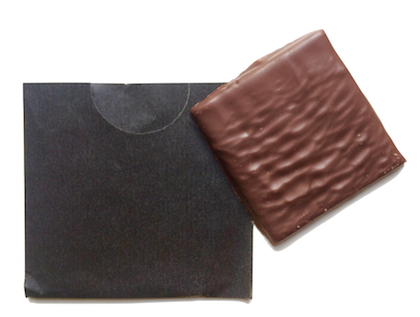Invertase

How do they put the soft centres into liqueur chocolates and after-dinner mints? With invertase, naturally.
PRACTICAL PROTOCOL
INITIAL RATE OF REACTION WITH INVERTASE AND DNSA
SOURCE
BioInvert is obtained from baker’s yeast, Saccharomyces cerevisiae.
COMMERCIAL USES
Invertase is widely-used in confectionery production. A well-known application is in the production of soft-centred sweets, such as after-dinner mints. Here, a solid paste with the consistency of fudge is made using sucrose (table sugar). A small amount of invertase is added to this fondant before it is enrobed in chocolate. During storage for a couple of weeks at 18 °C, the enzyme partially liquefies the sucrose within the chocolate shell. A US government chemist, H.S. Paine, first suggested this method in 1924. Modern machinery (that freezes the half-shell) allows syrupy centres to added to pre-cast chocolate shells (such as fondant-filled chocolate eggs), removing the need for enzymatic treatment.
Another common use is making invert sugar syrups e.g., for beekeeping (feeding honeybees in the autumn or spring when nectar-bearing flowers are few and far between).
EDUCATIONAL USES
Invertase was the enzyme used by Leonor Michaelis and Maud Menten in their pioneering studies of enzyme kinetics. The best way to assay invertase activity is to use DNSA reagent and a colorimeter. Details are given in the protocol linked to above left.
Is invertase the same as sucrase?
No, but you can use invertase to do the same job. [Although the names invertase and sucrase are sometimes used interchangeably they are different enzymes, as they break the disaccharide sucrose at slightly different locations. The products of the enzyme action, however, are exactly the same.]
ACTIVITY
Invertase splits the disaccharide sucrose into the monosaccharides glucose and fructose. Invertase is inhibited by high concentrations of its substrate, sucrose. The invertase we supply has optimum activity at 60 °C. Its optimum pH is 4.5 (the pH is usually adjusted to this level by the addition of citric acid to the reaction mix), although it is active between pH 3.0 and 5.5. Inactivation of the enzyme begins at 65 °C and the enzyme is totally inactivated after 5 minutes at 90 °C.
STORAGE
The enzyme preparation should be stored at 3–5 °C. At this temperature the enzyme will maintain its declared activity for at least a year. Do not freeze.
SAFETY

DANGER. May cause allergy or asthma symptoms or breathing difficulties if inhaled. See Safety Data Sheet for further advice.
SAFETY DATA SHEET
ORDERING
All of the prices on this page are in GBP and do not include Value Added Tax (VAT). This tax applies within the European Union only. Postage and handling must also be paid on orders from outside the United Kingdom. Details of how to order are given on the price list and on the Ordering web page.
Please note: We are unable to supply this product to addresses in the United States of America.
PLEASE NOTE: THE NCBE SUPPLIES THESE ENZYMES TO SCHOOLS AND COLLEGES FOR EDUCATIONAL USE ONLY. COMMERCIAL USERS OF ENZYMES OR THOSE WHO REQUIRE ENZYMES FOR RESEARCH PURPOSES SHOULD CONTACT THE ENZYME MANUFACTURERS OR OTHER SUPPLIERS, NOT THE NCBE.

